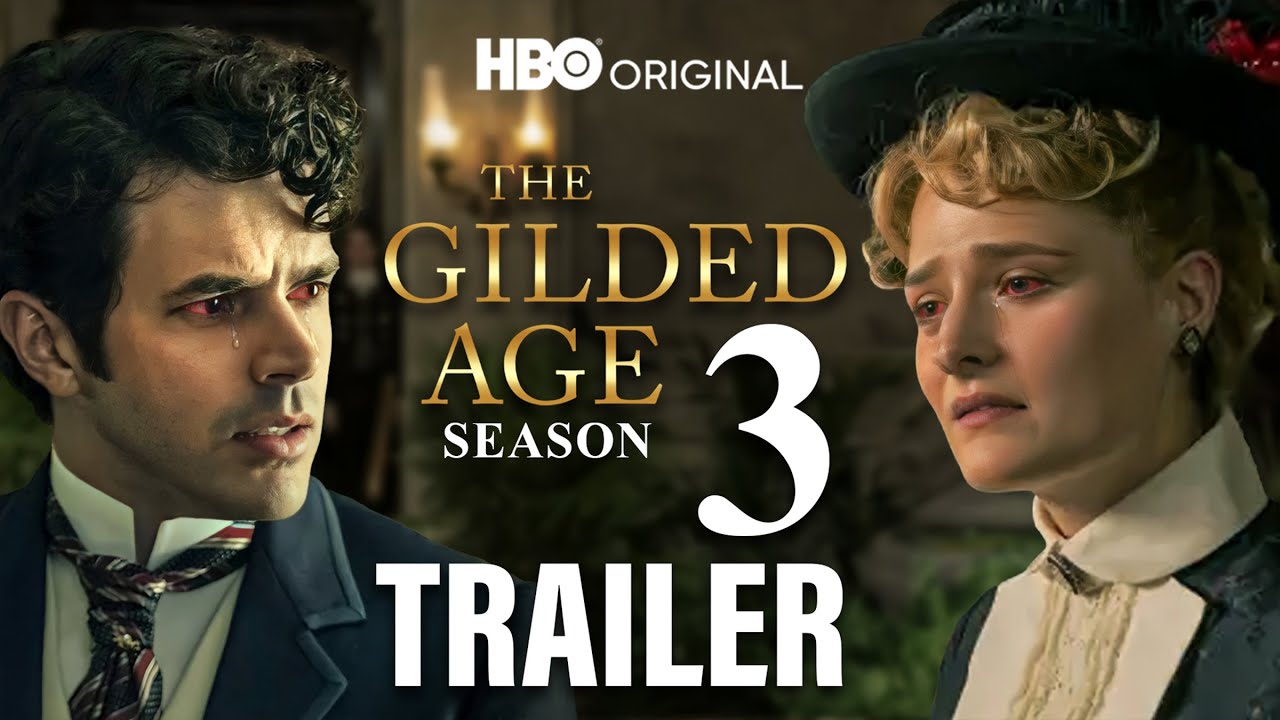The Gilded Age Season 3: Everything You Need to Know About the Return to New York's Elite
The grand ballrooms, intricate social maneuvers, and dazzling fashion of 1880s New York have captivated audiences worldwide. Julian Fellowes' critically acclaimed series, The Gilded Age, has masterfully brought this fascinating period to life, and fans are eagerly anticipating its next chapter. With two compelling seasons already under its belt, the burning question for enthusiasts is: "When is The Gilded Age Season 3 arriving?"
This ultimate guide will cover all the essential details about the upcoming season, including its release, cast updates, plot insights, and a deeper dive into the historical backdrop and production secrets that make this show a must-watch.

Part 1: Is The Gilded Age Coming Out with Season 3? (Release Date & Where to Watch)
Great news for fans of the old money versus new money drama! Yes, The Gilded Age is coming out with Season 3! HBO officially renewed the series for a third season in December 2023, shortly after the acclaimed Season 2 finale.
- Expected Release Window: While an exact The Gilded Age Season 3 release date has not yet been announced, given typical production schedules for shows of this scale, it's highly anticipated that Season 3 will premiere in late 2025 or early 2026. Filming is expected to begin in Summer/Fall 2024, followed by extensive post-production, including costume preparation, set design, and editing, which are hallmarks of the show's lavish aesthetic.
- Where to Watch Season 3 of The Gilded Age?: For viewers in the United States, Season 3 will premiere on HBO and will be available for streaming concurrently on Max. International audiences, including those in the UK, can expect to watch new episodes on Sky Atlantic and through the NOW streaming service. Viewers across Europe, Asia, and other regions can generally access the show via Max or local HBO-affiliated platforms.
- Season 2 Recap: For reference, Season 2 of The Gilded Age came out on October 29, 2023, concluding its run in December 2023. The quick renewal indicates strong performance and critical reception.
Part 2: Cast Changes and Character Fates in The Gilded Age Season 3
A show as rich in character as The Gilded Age naturally prompts questions about its ensemble. Fans are keen to know if The Gilded Age Season 3 cast will see any significant changes.
- Returning Main Cast: Expect the formidable cast to return, including Carrie Coon as the ambitious Bertha Russell, Christine Baranski as the steadfast Agnes van Rhijn, Cynthia Nixon as the compassionate Ada Brook, and Louisa Jacobson as the central figure, Marian Brook. Most, if not all, of the core ensemble, are expected to reprise their roles to continue their intricate storylines.
- Which Actor is Not Returning to The Gilded Age?: As of now, there have been no official announcements about any major cast members not returning for Season 3. However, with large ensemble casts, it's always possible for minor characters or guest stars to change. The series is known for its ability to seamlessly integrate new faces while maintaining its beloved core.
- Who Did Carrie Coon Replace in The Gilded Age?: This is a common misconception! Carrie Coon has been the magnificent Bertha Russell since the very beginning of The Gilded Age. She did not replace another actress in this role. Her powerful portrayal of the "new money" matriarch has been a defining element of the series.
- What Happened to Tom Raikes in The Gilded Age? Is Tom Raikes in Season 2?: Tom Raikes, Marian Brook's love interest from Season 1, ultimately did not appear in Season 2. His story concluded at the end of Season 1 when Marian, after a significant internal struggle, chose not to elope with him, recognizing that his ambitions for a comfortable life didn't align with her desire for more. His character was written out, allowing Marian to explore new romantic interests and independence in Season 2.
- Other Key Character Fates:Bertha Russell: Season 2 saw Bertha solidify her position in New York society, challenging the old guard and even conquering the opera house. Season 3 will likely see her continue her relentless ascent, potentially facing new rivals or unexpected challenges from within her own family.
- Agnes van Rhijn & Ada Brook: The sisters’ dynamic saw a heartwarming shift in Season 2 with Ada's marriage. Season 3 will explore Ada's new life and how it impacts the van Rhijn household, particularly the formidable Agnes.
- Marian Brook: Having navigated romantic complications, Marian is increasingly finding her voice and purpose. Season 3 will undoubtedly see her continue to challenge societal norms and explore her independence.
Part 3: Delving into the "Gilded Age": Historical Context & Real-Life Inspirations
The show's very title is steeped in history, and its narrative frequently blurs the lines between fact and fiction.
- Why is it called The Gilded Age?: The term "The Gilded Age" was coined by Mark Twain and Charles Dudley Warner in their 1873 novel, The Gilded Age: A Tale of Today. It describes the period in American history from roughly 1870 to 1900. It refers to a time of immense economic growth and industrial expansion, leading to colossal fortunes and lavish displays of wealth. However, "gilded" also implies that beneath the glittering surface lay widespread poverty, social inequality, and political corruption. The show perfectly captures this dichotomy of opulence and underlying tension.
- Is The Gilded Age a True Story?: No, The Gilded Age is not a true story in its entirety. The central characters and their personal narratives, such as the Russells and the van Rhijns, are fictional creations by Julian Fellowes. However, the series is meticulously researched and is set against a backdrop of actual historical events, social customs, and real figures from the era. This blend of fiction within a historically accurate framework is a hallmark of Fellowes' work.
- Real People vs. Fictional Characters:Is Agnes van Rhijn based on a real person?: While Agnes van Rhijn is a fictional character, she embodies the attitudes and social rigidity of the "old money" Dutch-American aristocracy that dominated New York society before the influx of new industrial wealth. She represents a type, rather than a specific individual.
- Was Ward McAllister a real person?: Yes, Ward McAllister was a very real and influential figure in Gilded Age New York society. He was a social arbiter who helped Caroline Astor (often referred to as "The Mrs. Astor") establish the infamous "Four Hundred" list of New York's elite. His portrayal in the show is largely accurate to his historical role.
- Who is Larry Russell based on?: Larry Russell, the architect son of George and Bertha, is a fictional character. However, his aspirations and challenges reflect the societal shifts of the time, where even the children of "new money" sought to make their mark in established professions, often against the backdrop of prejudice from the old guard. His character embodies the spirit of innovation and progress during this period.
- Other Historical Figures: The show often features appearances or mentions of other real historical figures, including Clara Barton (founder of the American Red Cross), T. Thomas Fortune (influential Black journalist), and various prominent industrialists and socialites, lending authenticity to the narrative.
Part 4: Behind the Scenes: Production Insights & Critical Reception
Beyond the story, The Gilded Age has a fascinating production story and a significant impact on its audience.
- Why are so many Broadway actors in The Gilded Age?: This is a deliberate and celebrated choice by Julian Fellowes and the casting directors. The show is set in New York City, a hub for Broadway talent. Many accomplished stage actors, including Audra McDonald, Kelli O'Hara, Nathan Lane, and Laura Benanti, bring their immense theatrical presence and vocal prowess to the screen. This enriches the show with incredibly strong performances, as many of these actors are trained in projecting character and emotion. It also provides a wonderful showcase for American theatrical talent.
- Why did The Gilded Age fail?: It's important to clarify that The Gilded Age did not fail. In fact, it has been a critical and commercial success for HBO. It garnered strong viewership, particularly for a period drama, and has been praised for its lavish production design, stunning costumes, and powerful performances. The show has received Emmy nominations for its artistry and storytelling. Any perception of "failure" might stem from comparisons to the colossal global phenomenon of Downton Abbey or simply individual taste, but by standard metrics, The Gilded Age has been a triumph for HBO, securing its quick renewal for Season 3.
- Production Excellence: The series is renowned for its commitment to historical accuracy in its visual elements. The incredible costumes, meticulously recreated sets in Upstate New York and Rhode Island, and stunning visual effects work together to transport viewers directly into the opulence of the late 19th century. The attention to detail in everything from silverware to horse-drawn carriages is part of its charm.
Part 5: What to Watch If You Like The Gilded Age? (Recommendations)
If you've binged both seasons of The Gilded Age and are craving more historical drama with intricate social dynamics and beautiful aesthetics, here are some excellent recommendations:
- Downton Abbey: Created by Julian Fellowes himself, Downton Abbey is the spiritual predecessor to The Gilded Age. Set in early 20th-century England, it explores the lives of the aristocratic Crawley family and their servants. It offers the same blend of drama, romance, and meticulous period detail.
- Bridgerton: This hugely popular Netflix series offers a more modern, diverse, and vibrant take on the Regency era in London. If you love the opulent balls, social seasons, and romantic entanglements of The Gilded Age, Bridgerton will be right up your alley, though with a different stylistic flair.
- Belgravia: Another Julian Fellowes creation, Belgravia is a limited series set earlier in 19th-century London, focusing on the secrets and scandals within the upper echelons of society. It shares the same attention to historical detail and social commentary.
- The Crown: For a different kind of period drama focusing on real historical figures, The Crown (Netflix) chronicles the reign of Queen Elizabeth II. While set in a more modern era, it offers deep dives into power, family dynamics, and the intersection of personal and public life, much like The Gilded Age.
- Victoria: This British historical drama (available on PBS in the US) follows the early reign of Queen Victoria. It offers lavish costumes, grand settings, and insights into royal life, appealing to fans of historical biography and romance.
- Selfridge: Set in early 20th-century London, this series follows the flamboyant American Harry Selfridge as he opens a groundbreaking department store. It combines themes of ambition, social change, and personal drama, much like the Russell family's story.
Part 6: The Gilded Age Season 3 FAQs
Q: Is The Gilded Age a true story?
A: No, the core narrative and main characters of The Gilded Age are fictional. However, the show is meticulously set within the authentic historical context of the 1880s American Gilded Age, incorporating real historical figures and events into its fictionalized world.
Q: Why is it called The Gilded Age?
A: The term "The Gilded Age" was coined by Mark Twain to describe a period of rapid economic growth and industrialization in the United States (roughly 1870-1900). It suggests that while the era appeared prosperous and glittering on the surface, it often concealed underlying social problems, corruption, and inequality.
Q: Is Agnes van Rhijn based on a real person?
A: Agnes van Rhijn is a fictional character. She is representative of the established "old money" Dutch-American aristocracy in New York, who were resistant to the social changes brought by the newly wealthy industrialists of the period.
Q: Was Ward McAllister a real person?
A: Yes, Ward McAllister was indeed a real historical figure. He was a prominent social arbiter in New York City during the Gilded Age, instrumental in defining the city's elite social circles and the infamous "Four Hundred" list.
Q: Who is Larry Russell based on?
A: Larry Russell is a fictional character within the show. His ambitions as an architect and his challenges as part of a "new money" family navigating established society are reflective of the societal shifts and aspirations of the era, rather than being based on one specific individual.
Q: What happened to Tom Raikes in The Gilded Age?
A: Tom Raikes was Marian Brook's love interest in Season 1. Their relationship ended when Marian chose not to elope with him, realizing their differing life paths. He did not appear in Season 2 of The Gilded Age.
Q: Why did The Gilded Age fail?
A: This is a misconception. The Gilded Age did not fail. It has been a successful and critically praised series for HBO, garnering strong viewership and receiving award nominations for its production values, acting, and compelling storytelling. It was quickly renewed for its third season.
Q: Who did Carrie Coon replace in The Gilded Age?
A: Carrie Coon has played Bertha Russell since the very beginning of The Gilded Age. She did not replace another actress in this role.
Q: Why are so many Broadway actors in The Gilded Age?
A: The show's creator, Julian Fellowes, often casts accomplished stage actors. Given that The Gilded Age is set and largely filmed in New York City, the home of Broadway, it's a natural fit to draw from the immense talent pool of acclaimed theatrical performers, which significantly enhances the show's caliber.






 HitPaw Edimakor
HitPaw Edimakor HitPaw Univd (Video Converter)
HitPaw Univd (Video Converter)  HitPaw VikPea (Video Enhancer)
HitPaw VikPea (Video Enhancer)
Share this article:
Select the product rating:
Daniel Walker
Editor-in-Chief
This post was written by Editor Daniel Walker whose passion lies in bridging the gap between cutting-edge technology and everyday creativity. The content he created inspires the audience to embrace digital tools confidently.
View all ArticlesLeave a Comment
Create your review for HitPaw articles